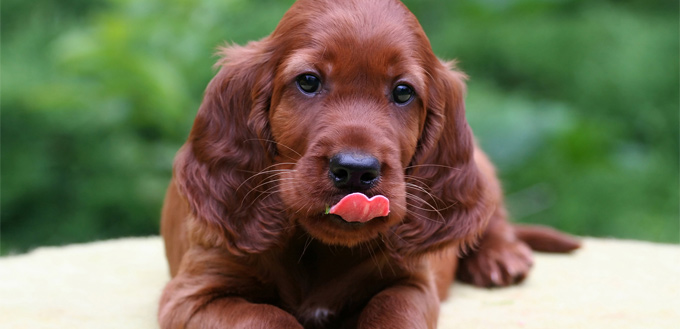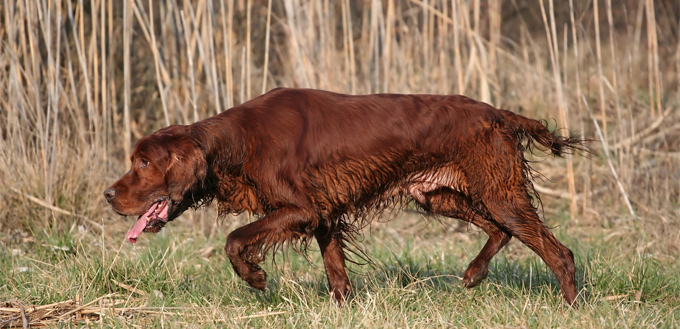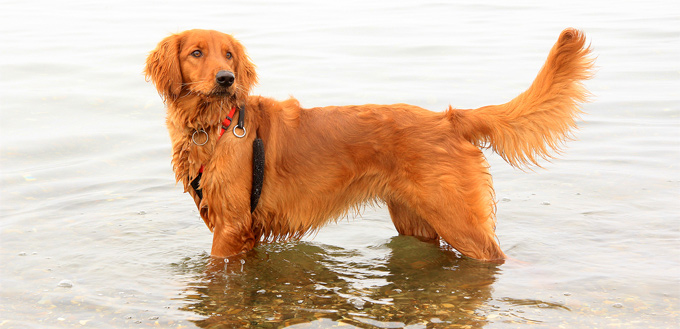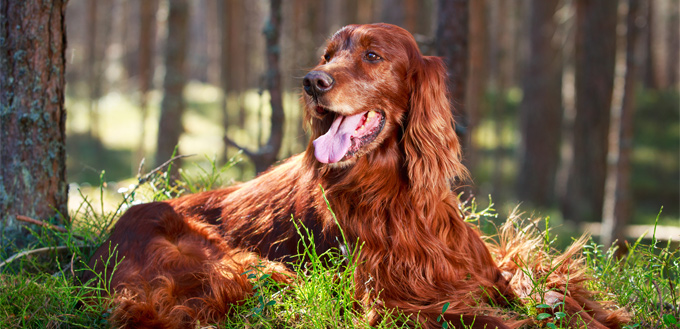If not for the reddish mahogany color of its coat, its slightly smaller head, and definitely taller body, you can easily mistake the Irish Setter for the Golden Retriever. After all, the creation of the modern Golden Retriever by Marjoribanks in the 19th century utilized an Irish Setter in the extensive breeding program for Golden Retrievers. This rollicking and rowdy redhead comes with the vigor of a German Shepherd, the friendliness of a Golden Retriever, the sweet and good-natured temperament of the Labrador, and the trainability of a Poodle. Unfortunately, it can also have the stubbornness of a scenthound, but will always do its best to be a good family friend.
History of the Irish Setter
Setters are gundogs that are typically used together with pointers in the hunt for grouse, pheasant, and quail. They are very different from other types of hunting dogs in that they don’t chase the game upon seeing one. Instead, they ‘freeze’ and assume a somewhat ‘crouching’ position to indicate the presence of the hunter’s quarry. They will never go after the game once found. They will ‘set’ it up for their human hunters to go in for the kill.

The very first reference to a ‘setter’ was found in the De Canibus Britannicus in 1570, written by Caius. The text described how a dog is known as ‘Setter’ is invaluable among those who enjoy hunting wildfowl. The dog, Caius described, will diligently track the game while looking intently at the hand gestures of its owner. He also described that once the dog has found its prey, it freezes on its tracks and assume a crouching position like a ‘worm’ crawling on the surface of the earth.
Some believed that Caius was not referring to the Irish Setter, but rather a spaniel of the setting type. However, the same literature also revealed that the ‘setter’ came in either white with spotted markings or red. This led dog historians to believe that the Irish Setter is a product of selective breeding practices that may have started as early as the 15th century.
While there is still debate on whether the Irish Setter may have had a much earlier beginning than initially thought, the common knowledge is that this breed is a product of 18th-century Irish dog breeding practices that combined the English Setter, Gordon Setter, Pointer, and Spaniel. This resulted in what many dog fanciers consider to be the first Irish Setters. These dogs were also referred to as ‘red spaniels’ with reference to ‘modder rhu’ which is the Gaelic equivalent for ‘red dog’.
The first Irish Setter did not have that rich mahogany color we see in the breed today. Instead, it came in two types. The first was a combination of red and white which closely resembles the description of 16th century Caius. The second was known as the ‘shower of hail’ since the dog had predominantly red coat, but with plenty of small white specks.
By 1793, the de Freyne family has already been keeping very detailed stud records of Irish Setter breeding programs. Other prominent Irish gentry has also begun breeding Irish Setters around this time. They included Lord Dillon, the Marquis of Waterford, and Lord Clancarty.
The Earl of Enniskillen was known to be especially fond of the nearly-solid mahogany red color of the Irish Setter that he set out to breed only those that will produce solid red coats. By 1812, the Earl was already breeding only red Irish Setters. As soon as dog shows were introduced in the middle of the 19th century, the solid-red dogs were considered to be the ideal color of the Irish Setter. Other Irish who bred red-only dogs included Sir St. George Gore and Jason Hazzard.
In 1875, Elcho became the very first Irish Setter to have been imported into the US. Elcho proved to be such a charmer in the show ring while displaying its remarkable hunting skills out in the field. It was Admiral that became the first Irish Setter to be registered by the AKC in 1878.
From 1874 to 1948, the Irish Setter was one of America’s most popular breeds. It was a constant favorite in dog shows. During this period, there were a total of 760 Irish Setters that were crowned as conformation champions. Unfortunately, only 5 Irish Setters became field champions in the same time frame. This prompted fanciers of the original Irish Setter to work for the revival of the canine breed as a working type of dog.
It is for this reason that we can see two types of Irish Setters today. One is larger and heavier that is primarily intended for conformation dog shows while the other is lighter and sleeker intended for the field as a working dog.
Quick Facts
If you fancy getting the super-enthusiastic and tireless Irish Setter into your life, then you really need to learn the following facts by heart.
- The Irish Setter can come in two types: a show dog and a working dog. Show Irish Setters are generally larger, beefier, and heftier than their working counterparts that are leaner and lighter.
- This dog can grow anywhere from 24 inches to as high as 28 inches, although the working red dog can be slightly smaller by an inch or two.
- The Federation Cynologique Internationale puts the acceptable height range to be 23 to 26.5 inches for males and 21.5 to 24.5 inches for females.
- These four-legged mahoganies can weigh 65 to 75 lbs for males and 55 to 65 lbs for females.
- On average, Irish Setters have a life expectancy of 10 to 12 years.
- The characteristic color of this dog’s coat is rich chestnut red or deep mahogany.
- The coat is medium in length and may have small specks of white on its throat, chest, or toes. It is also possible to have a very narrow streak of whitish fur on its head.
- The head of the Irish Setter is lean and long, but with a finely chiseled appearance.
- It’s got dark eyes that convey intelligence and exceptional taste for good humor (more like the Poodle).
- The ears are rather long and droopy just like a Golden Retriever.

Things You Should Know
It’s no secret that a lot of people would like to have the Irish Setter in their lives. But there are some things that you have to know first.
Training
Training is an absolute must for this dog. They can be as intelligent as a Poodle, but can also display the stubbornness of a Beagle or any other scenthound. Obedience training is imperative for the young Irish Setter especially if you don’t want it to use its stubbornness and mischievous nature into something more destructive.
Don’t ever think that training the Irish Setter is going to be a walk in the park. On the contrary, it is one of the most challenging dog breeds to train. Like most other hunting dogs, the Irish Setter’s inquisitive nature can get in the way of effective training. The only way you can divert its attention from something that it is already focused on is to provide it with something more interesting. This is the key. If you can maintain its interest in something, it will happily indulge you in your training sessions.
Feeding
This breed is a deep-chested dog. This means it is prone to gastric dilatation volvulus. As such, it is imperative that it be fed in smaller portions but in greater frequency. For example, you can feed it 3 times a day instead of the usual twice daily feeding recommendations.
This is a moderately muscular build. It is also very energetic and can run and play all day without ever tiring. It is for this reason that it should be fed a high-protein, calorie-dense diet with the calories coming mostly from proteins. Don’t give starches or grains as these can increase the formation of gas and lead to bloat.
Related Post: Best High Protein Dog Food
Exercise
The athletic and highly-energetic Irish Setter requires at least 60 minutes of vigorous walking, jogging, running, or hiking every single day. This can be divided into 30-minute sessions to make it more manageable. It is best that the dog is allowed to run freely in a spacious backyard. If none is available, then it should be allowed to visit the dog park or any other wide-open space where it can roam freely but safely.
Mental exercises are equally important. These dogs may not be as smart as the Border Collie, but they do have the intelligence that makes them truly phenomenal hunters. How else do you think they are able to freeze themselves and set up their quarry for their human hunting partners to pounce on? That being said, they will need a lot of mental stimulation so they will never get bored.
Socialization
Leave the Irish Setter by itself for a few hours and you’ll come back to a house that looks like it has been hit by an F5 tornado. Like its descendant, the Golden Retriever, the Irish Setter has a very serious separation anxiety issue. It can get really unhappy if it sees that its owners have left it at home. It is important to remember that this dog is people-oriented. It doesn’t do its thing hunting for game fowl or even winning championships in show rings just because it wants to, but rather because it knows it makes its people happy. Now imagine if you leave it behind. It will feel as if it was betrayed.
When it comes to other people, children, other dogs, and other pets, the Irish Setter can do exceptionally well. However, this doesn’t come automatically. You have to actively socialize it as a puppy so that it grows up into a dog with a well-balanced temperament. Like the Golden Retriever, the Irish Setter is exceptionally friendly even to strangers.

Grooming
The main draw for the Irish Setter is its magnificent mahogany red coat. It is important that it be brushed every day to retain its silky smoothness and prevent tangles, mats, and knots. While this breed is not a heavy shedder, it will still cause some pet hair concerns during certain seasons of the year. Deshedding tools, shampoos, and vacuum cleaners for dog hair should be ready around this time of the year.
As always, this dog needs its teeth and gums to be brushed every day. Its nails should also be carefully inspected and trimmed every month while its ears require more frequent weekly inspection and cleaning.
You may also like our guides on Dog Toothbrush, Dog Shedding Brush, Dog Shampoo, Dog Grooming Clippers, and Dog Detangler Sprays.
Health
Aside from bloat or gastric dilatation volvulus that we already mentioned, Irish Setters are also prone to hip dysplasia, eye problems, cancer, hypothyroidism, epilepsy, Von Willebrand’s disease, heart problems, and osteosarcoma. This is also one of several dog breeds that may have an intolerance to gluten. As such, you should never give dog food that contains gluten.
The Irish Setter is ideal for…
- People who love to exercise or engage in physical activities
- Families and singles who live in properties with spacious backyards
- Those who understand what it means to train and socialize a dog as young as a puppy
- Those who will never leave their pets alone even for a few hours at a time
- Folks who like a friendly, smart, and affectionate family dog
Too bad, if you are any of the following, the Irish Setter isn’t for you.
- Absolutely new to pet parenthood
- Don’t have a clue as to what positive reinforcement is
- Doesn’t think that training, exercise, and socialization are important for a dog

Temperament
Matching its flame-colored coat, this dog has a very flamboyant personality. It is always boisterous and joyful in everything that it does. It has a good sense of humor that is very much like the clownish nature of the Poodle yet can also be as mischievous as the Border Collie. It is very rambunctious when in the company of kids, but will always shower its family with love, devotion, and affection. It is smart but can be really stubborn. Great patience is required if one wants the Irish Setter to follow commands. However, having a great sense of humor will usually work for this fun-loving hound.
The Irish Setter is a beautiful breed; no doubt about it. Its flame-colored coat matches well with its rambunctious, exuberant, and flamboyant personality that should fit right into the life of a similarly-natured dog owner.
Sources:
- Irish Setter, VetStreet





